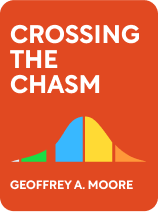

This article is an excerpt from the Shortform book guide to "Crossing the Chasm" by Geoffrey Moore. Shortform has the world's best summaries and analyses of books you should be reading.
Like this article? Sign up for a free trial here .
What is word-of-mouth marketing? What are the best ways to generate word-of-mouth referrals?
Word-of-mouth (WOM) marketing is a way of promotion where customers spread goodwill about a brand and its products through conversations. There are two primary channels you can use to create a word-of-mouth marketing strategy for your business: vertical media and business press.
We’ll discuss both of these strategies below.
Word-of-Mouth Promotion
The key thing to keep in mind when designing your word-of-mouth marketing strategy is to stay away from using manipulative tactics. This could involve bombarding potential customers with every possible reason they should buy your product through an overbearing ad campaign, or selectively comparing your product to alternatives that make it look good, while omitting other alternatives. However, people tend to recognize these tactics for what they are.
(Shortform note: In Start with Why, Simon Sinek condemns manipulative advertising, saying that it may generate sales in the short term, but it prompts the customer to make poor decisions, which results in poor customer relations for the company. He points out that in some cases, these poor decisions can also have serious consequences for the industry or even the economy in general. As an example, Sinek argues that the “Great Recession” of 2008 was ultimately caused by manipulative advertising on the part of banks, which led people to take out excessive loans and make poor financial investments.)
Instead, focus on building mutually beneficial relationships with key influencers in your target market, so that their positive impressions will build a “word-of-mouth campaign” within your industry. It takes time to identify these people and establish an ongoing dialogue with them. However, once these relationships are in place, they help to secure your position, because people prefer to do business with people they know.
(Shortform note: In Perennial Seller, Ryan Holiday says the key to effectively influencing the influencers in your industry is to see things from their perspective: Influencers are typically people who have earned a reputation by being the first to recommend products that are genuinely valuable. They want to maintain that reputation. Thus, if you can present them with sample products that exceed their expectations, or show them how your product provides a better solution to their followers’ compelling problem, you can turn them into advocates for your product.)
Communication Channels
There are two main channels for generating word-of-mouth:
The first channel is the business press. The established business press has a strong reputation and they are careful to safeguard it. As such, it’s harder to get their attention, especially as as a startup, but doing so boosts your reputation significantly.
One of the best ways to garner the attention of the business press is to leverage your partnerships. When companies come together to supply an emerging market or address a market issue, the business press is often interested in covering these stories. You can, for example, hold a press conference or sponsor a trade conference with representatives from your partner companies, as well as customers and independent analysts all present, to initiate relationships with business press editors over your story.
The second channel is “vertical media,” which includes publications for the specific industry niche you are targeting, as well as conferences and trade shows where vendors can participate almost like consultants, presenting solutions to customers’ needs. Establishing a presence within the “vertical media” of your target niche allows you to connect with influencers in your industry.
| Additional Communication Channels McKenna discusses the business press and direct interaction with potential customers at trade shows. Additionally, he points out that the venture capitalists backing your company are often influential people, whose word can be indispensable for getting your word-of-mouth promotion campaign started. He also advises getting the people in your distribution network on board with your positioning claims, as they can influence customers directly. Finally, he points out that everyone who interacts with your company in any way will develop an impression of your company, which will ultimately influence your positioning. This could include people who provide services to you, interview for jobs, or visit the company for some other reason. He says that all these people can become advocates for your company’s positioning if you treat them right. Since McKenna published his advice, online social media has opened up new communication channels as well. For example, your company can start a YouTube channel to tell your own story in your own words. If you make content that’s in the same vein as what your target customers are already watching, YouTube’s video suggestion algorithms will help them find it. Similarly, you can tell your story on Facebook, LinkedIn, Twitter, or any number of other sites. And on almost any platform, if people like the content you post, they can share it with their friends just by pressing a button. That said, in Contagious, Jonah Berger cautions that even today, only about 7% of word-of-mouth communication takes place online, with the remaining 93% resulting from in-person contact. Thus, even with social media communication channels, it’s important to make sure your message is clear and simple enough to be passed on by traditional word of mouth. |

———End of Preview———
Like what you just read? Read the rest of the world's best book summary and analysis of Geoffrey Moore's "Crossing the Chasm" at Shortform .
Here's what you'll find in our full Crossing the Chasm summary :
- An explanation of the chasm phenomenon that many new high-tech products face
- How to pilot a product across this chasm to mainstream success
- The problems with the Technology Adoption Life Cycle (TALC) model






